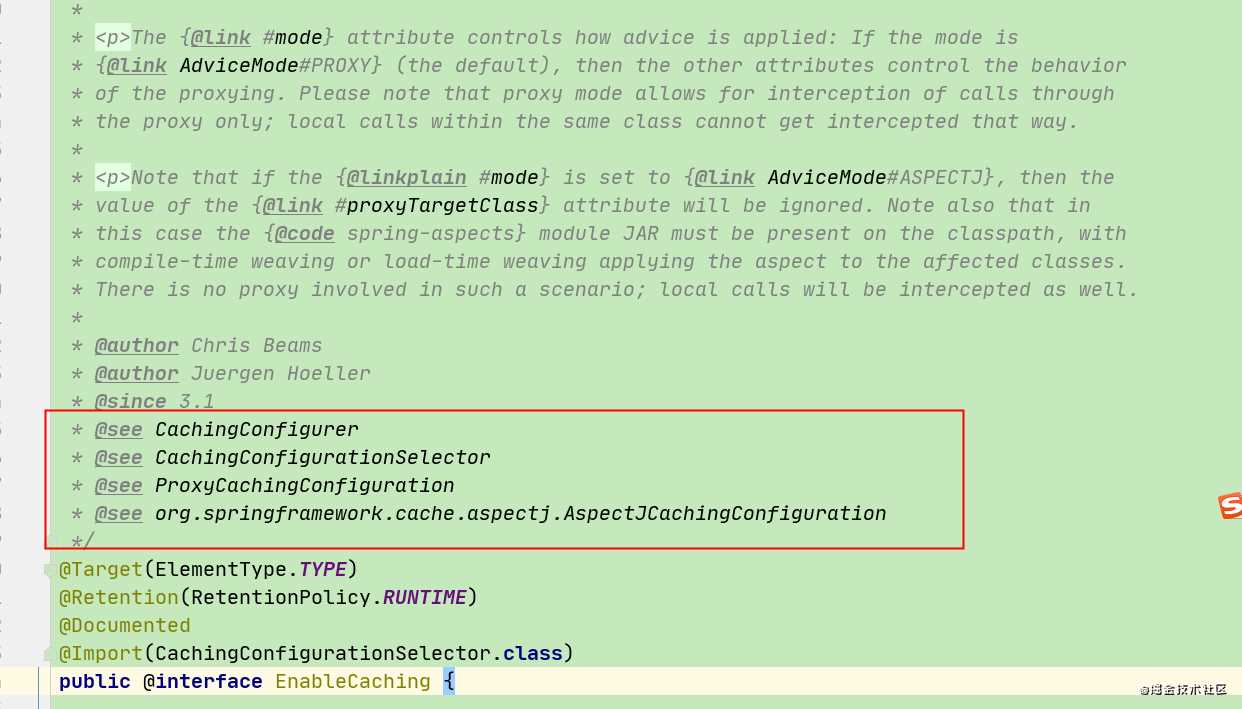背景
项目中,使用@Cacheable进行数据缓存。发现:当redis宕机之后,@Cacheable注解的方法并未进行缓存冲突,而是直接抛出异常。而这样的异常会导致服务不可用。
原因分析
我们是通过@EnableCaching进行缓存启用的,因此可以先看@EnableCaching的相关注释

通过@EnableCaching的类注释可发现,spring cache的核心配置接口为:org.springframework.cache.annotation.CachingConfigurer
|
1
2
3
4
5
6
7
8
9
10
11
12
13
14
15
16
17
18
19
20
21
22
23
24
25
26
27
28
29
30
31
32
33
34
35
36
37
38
39
40
41
42
43
44
45
46
47
48
49
50
51
52
53
54
55
56
57
58
59
60
61
62
63
64
65
66
67
68
69
70
71
72
73
74
75
76
77
78
79
80
81
82
83
84
85
86
87
88
89
90
91
92
93
94
95
96
97
98
99
100
101
102
103
104
105
106
107
108
109
110
|
/** * Interface to be implemented by @{@link org.springframework.context.annotation.Configuration * Configuration} classes annotated with @{@link EnableCaching} that wish or need to * specify explicitly how caches are resolved and how keys are generated for annotation-driven * cache management. Consider extending {@link CachingConfigurerSupport}, which provides a * stub implementation of all interface methods. * * <p>See @{@link EnableCaching} for general examples and context; see * {@link #cacheManager()}, {@link #cacheResolver()} and {@link #keyGenerator()} * for detailed instructions. * * @author Chris Beams * @author Stephane Nicoll * @since 3.1 * @see EnableCaching * @see CachingConfigurerSupport */public interface CachingConfigurer { /** * Return the cache manager bean to use for annotation-driven cache * management. A default {@link CacheResolver} will be initialized * behind the scenes with this cache manager. For more fine-grained * management of the cache resolution, consider setting the * {@link CacheResolver} directly. * <p>Implementations must explicitly declare * {@link org.springframework.context.annotation.Bean @Bean}, e.g. * <pre class="code"> * Configuration * EnableCaching * public class AppConfig extends CachingConfigurerSupport { * Bean // important! * Override * public CacheManager cacheManager() { * // configure and return CacheManager instance * } * // ... * } * </pre> * See @{@link EnableCaching} for more complete examples. */ CacheManager cacheManager(); /** * Return the {@link CacheResolver} bean to use to resolve regular caches for * annotation-driven cache management. This is an alternative and more powerful * option of specifying the {@link CacheManager} to use. * <p>If both a {@link #cacheManager()} and {@code #cacheResolver()} are set, * the cache manager is ignored. * <p>Implementations must explicitly declare * {@link org.springframework.context.annotation.Bean @Bean}, e.g. * <pre class="code"> * Configuration * EnableCaching * public class AppConfig extends CachingConfigurerSupport { * Bean // important! * Override * public CacheResolver cacheResolver() { * // configure and return CacheResolver instance * } * // ... * } * </pre> * See {@link EnableCaching} for more complete examples. */ CacheResolver cacheResolver(); /** * Return the key generator bean to use for annotation-driven cache management. * Implementations must explicitly declare * {@link org.springframework.context.annotation.Bean @Bean}, e.g. * <pre class="code"> * Configuration * EnableCaching * public class AppConfig extends CachingConfigurerSupport { * Bean // important! * Override * public KeyGenerator keyGenerator() { * // configure and return KeyGenerator instance * } * // ... * } * </pre> * See @{@link EnableCaching} for more complete examples. */ KeyGenerator keyGenerator(); /** * Return the {@link CacheErrorHandler} to use to handle cache-related errors. * <p>By default,{@link org.springframework.cache.interceptor.SimpleCacheErrorHandler} * is used and simply throws the exception back at the client. * <p>Implementations must explicitly declare * {@link org.springframework.context.annotation.Bean @Bean}, e.g. * <pre class="code"> * Configuration * EnableCaching * public class AppConfig extends CachingConfigurerSupport { * Bean // important! * Override * public CacheErrorHandler errorHandler() { * // configure and return CacheErrorHandler instance * } * // ... * } * </pre> * See @{@link EnableCaching} for more complete examples. */ CacheErrorHandler errorHandler();} |
该接口errorHandler方法可配置异常的处理方式。通过该方法上的注释可以发现,默认的CacheErrorHandler实现类是org.springframework.cache.interceptor.SimpleCacheErrorHandler
|
1
2
3
4
5
6
7
8
9
10
11
12
13
14
15
16
17
18
19
20
21
22
23
24
25
26
27
28
29
|
/** * A simple {@link CacheErrorHandler} that does not handle the * exception at all, simply throwing it back at the client. * * @author Stephane Nicoll * @since 4.1 */public class SimpleCacheErrorHandler implements CacheErrorHandler { @Override public void handleCacheGetError(RuntimeException exception, Cache cache, Object key) { throw exception; } @Override public void handleCachePutError(RuntimeException exception, Cache cache, Object key, Object value) { throw exception; } @Override public void handleCacheEvictError(RuntimeException exception, Cache cache, Object key) { throw exception; } @Override public void handleCacheClearError(RuntimeException exception, Cache cache) { throw exception; }} |
SimpleCacheErrorHandler类注释上说明的很清楚:对cache的异常不做任何处理,直接将该异常抛给客户端。因此默认的情况下,redis服务器异常后,直接就阻断了正常业务
解决方案
通过上面的分析可知,我们可以通过自定义CacheErrorHandler来干预@Cacheable的异常处理逻辑。具体代码如下:
|
1
2
3
4
5
6
7
8
9
10
11
12
13
14
15
16
17
18
19
20
21
22
23
24
25
26
27
28
29
30
31
32
33
34
35
36
37
38
|
public class RedisConfig extends CachingConfigurerSupport { /** * redis数据操作异常处理。该方法处理逻辑:在日志中打印出错误信息,但是放行。 * 保证redis服务器出现连接等问题的时候不影响程序的正常运行 */ @Override public CacheErrorHandler errorHandler() { return new CacheErrorHandler() { @Override public void handleCachePutError(RuntimeException exception, Cache cache, Object key, Object value) { handleRedisErrorException(exception, key); } @Override public void handleCacheGetError(RuntimeException exception, Cache cache, Object key) { handleRedisErrorException(exception, key); } @Override public void handleCacheEvictError(RuntimeException exception, Cache cache, Object key) { handleRedisErrorException(exception, key); } @Override public void handleCacheClearError(RuntimeException exception, Cache cache) { handleRedisErrorException(exception, null); } }; } protected void handleRedisErrorException(RuntimeException exception, Object key) { log.error("redis异常:key=[{}]", key, exception); }} |
到此这篇关于Spring @Cacheable redis异常不影响正常业务方案的文章就介绍到这了,更多相关Spring @Cacheable redis异常内容请搜索服务器之家以前的文章或继续浏览下面的相关文章希望大家以后多多支持服务器之家!
原文链接:https://juejin.cn/post/6930545205036875784















